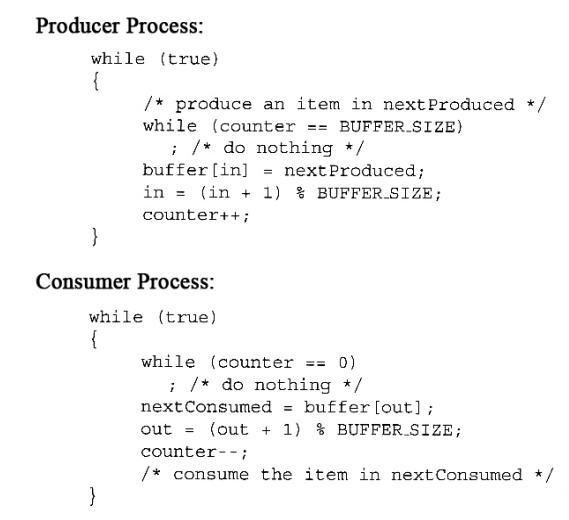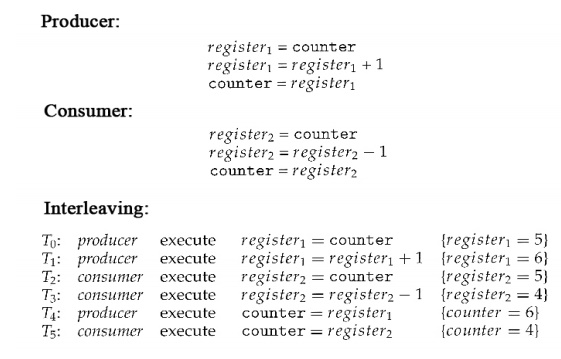Chapter: Operating Systems : Process Scheduling and Synchronization
Process Synchronization
PROCESS SYNCHRONIZATION
1. Background
Producer
code
item nextProduced;
while( true ) {
/* Produce an item and store it in nextProduced */
nextProduced = makeNewItem( . . . );
/* Wait for space to become available */ while( ( ( in + 1 ) %
BUFFER_SIZE ) == out )
; /* Do
nothing */
/* And then store the item and repeat the loop. */ buffer[ in
] = nextProduced;
in = ( in
+ 1 ) % BUFFER_SIZE;
}
Consumer
code
item
nextConsumed;
while(
true ) {
/* Wait for an item to become available */ while( in == out )
; /* Do
nothing */
/* Get the next available item */ nextConsumed = buffer[ out
];
out = (
out + 1 ) % BUFFER_SIZE;
/* Consume the item in nextConsumed ( Do something
with it ) */
}
ü The only
problem with the above code is that the maximum number of items which can be
placed into the buffer is BUFFER_SIZE - 1. One slot is unavailable because
there always has to be a gap between the producer and the consumer.
ü We could
try to overcome this deficiency by introducing a counter variable, as shown in
the following code segments:

ü Unfortunately
we have now introduced a new problem, because both the producer and the
consumer are adjusting the value of the variable counter, which can lead to a
condition known as a race condition. In this condition a piece of code may or
may not work correctly, depending on which of two simultaneous processes
executes first, and more importantly if one of the processes gets interrupted
such that the other process runs between important steps of the first process.
( Bank balance example discussed in class. )
ü The
particular problem above comes from the producer executing
"counter++" at the same time the consumer is executing
"counter--". If one process gets part way through making the update
and then the other process butts in, the value of counter can get left in an
incorrect state.
ü But, you
might say, "Each of those are single instructions - How can they get
interrupted halfway through?" The answer is that although they are single
instructions in C++, they are actually three steps each at the hardware level:
(1)Fetch counter
from memory into a register,
(2)increment
or decrement the register, and
(3)Store the
new value of counter back to memory. If the instructions from the two processes
get interleaved, there could be serious problems, such as illustrated by the
following:

Related Topics